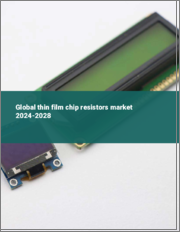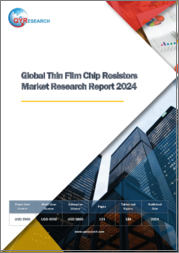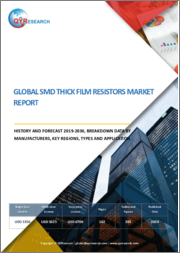
|
시장보고서
상품코드
1477021
세계 후막 저항기 시장 : 시장 규모, 점유율 분석 - 동향, 촉진요인, 경쟁 구도 및 예측(2024-2030년)Thick Film Resistor Market Size & Share Analysis - Trends, Drivers, Competitive Landscape, and Forecasts (2024-2030) |
||||||
세계의 후막 저항기 시장은 2023년에 7억 1,220만 달러의 규모에 도달한 후, CAGR 5% 이상의 CAGR로 성장하여 2030년에는 10억 1,420만 달러로 확대될 것으로 예상됩니다.
HEV의 구동에는 전기 구동, 내연 엔진, 회생 브레이크, 자율 발진/정지 시스템, 액추에이터 등 광범위한 자동차 기술이 채용되고 있습니다. 이러한 기술을 완벽하게 통합하고 전력을 효율적으로 관리하려면 복잡한 전자 제어 장치(ECU)가 필요합니다. 이러한 기술의 응용과 하이브리드 전기자동차 자체 수요 증가가 저항기 수요 증가를 밀어올릴 것으로 보입니다.
상용차는 승용차에 비해 안전성이나 고급성이 떨어집니다. 따라서 각국의 규제기관은 교통안전을 높이고 환경친화적이고 효율적인 사람이나 물건의 운송을 실현하기 위해 상용차의 기준을 갱신하고 있습니다. 인도 정부는 2023년 7월, 2025년 1월부터 트럭 객실에 에어컨 시스템을 설치하도록 지시했습니다. 미국에서는 연방 자동차 운송 안전국(FMCSA)이 모든 상용 트럭에 ELD(전자 로깅 장치)를 설치하도록 지시하고 있습니다. 이러한 가이드라인은 상용차에 전자기기의 채용을 뒷받침하고, 순차적으로 업계의 확대를 지원하고 있습니다.
시장 인사이트
지역별로는 2023년에 아시아태평양이 약 45%의 점유율을 차지하고 향후 수년간 가장 높은 CAGR로 성장할 예정입니다. 이 배경에는 전자 및 전기산업에 있어서 부품 요구 증가, 많은 진출기업의 존재, 자동차 생산 대수를 늘리기 위한 신기술에 대한 자금 제공 증가가 있습니다. 중국은 자동차 업계의 가장 큰 중심지로 여겨지고 있으며, 2025년에는 국내 자동차 생산 대수가 3,500만대에 달할 것으로 예상되는 등 세계 최대 시장으로 계속되고 있습니다.
북미 시장도 높은 점유율을 차지하고 있습니다. 이는 항공우주 및 군사 분야에서 고품질 전자부품에 대한 요구가 급증하고 있기 때문이라고 생각됩니다. 북미에서는 후막 저항기의 높은 내구성, 신뢰성, 가혹한 환경에 견딜 수 있는 능력이 받아들여지고 있습니다. 또한 IoT의 도래도 북미에서의 산업 확대를 뒷받침하고 있습니다. 후막 저항기는 접속된 센서나 액추에이터에 널리 채용되고 있기 때문입니다.
최종 사용자별로 자동차 카테고리는 2030년까지 약 40%의 점유율을 차지하며 최대 점유율을 차지할 가능성이 높습니다. 다양한 외부 요인에 대한 내성과 내구성을 위해 자동차 용도로 채용되고 있기 때문이라고 생각됩니다. 저항기는 습기, 충격 및 열에 대한 높은 내성을 가지므로 자동차 전자 회로의 중요한 요소입니다. 차량용 후막 칩 저항기는 다양한 크기, 작동 전압 및 저항 값 수준의 제품이 널리 제공됩니다. 이러한 제품은 AEC(Automotive Electronics Council)가 실시하는 엄격한 시험 및 기타 다양한 조건을 충족시키기 위한 것으로, AEC-Q200을 준수합니다.
이 업계는 대기업이 있기 때문에 통합이 적당히 진행되고 있습니다. 이 업계의 대기업은 시장 점유율을 확대하고 수익성을 높이기 위해 제휴 및 인수 등 다양한 전략을 추진하고 있습니다.
본 보고서에서는 세계의 후막 저항기 시장에 대해 분석하고, 시장의 기본 구조, 최신 정세와 주요 촉진·억제요인, 세계 전체 및 지역별·주요 국가 시장 규모의 동향 전망(수량 및 금액 기준), 2017-2030년), 최종 사용자별, 유형별 상세 동향, 현재 시장 경쟁 구도, 주요 기업 프로파일 등의 정보를 전해드립니다.
목차
제1장 분석 범위
제2장 분석 방법
제3장 주요 요약
제4장 시장 지표
제5장 업계 전망
- 시장 역학
- 동향
- 성장 촉진요인
- 억제요인/과제
- 성장 촉진요인/억제요인의 영향 분석
- 신형 코로나 바이러스 감염(COVID-19)의 영향
- Porter's Five Forces 분석
제6장 세계 시장
- 개요
- 시장 규모 : 최종사용자별(2017-2030년)
- 시장 수익 : 최종사용자별(2017-2030년)
- 시장 규모 : 유형별(2017-2030년)
- 시장 수익 : 유형별(2017-2030년)
- 시장 규모 : 지역별(2017-2030년)
- 시장 수익 : 지역별(2017-2030년)
제7장 북미 시장
- 개요
- 시장 규모 : 최종사용자별(2017-2030년)
- 시장 수익 : 최종사용자별(2017-2030년)
- 시장 규모 : 유형별(2017-2030년)
- 시장 수익 : 유형별(2017-2030년)
- 시장 규모 : 국가별(2017-2030년)
- 시장 수익 : 국가별(2017-2030년)
제8장 유럽 시장
제9장 아시아태평양 시장
제10장 라틴아메리카 시장
제11장 중동 및 아프리카 시장
제12장 미국 시장
- 개요
- 시장 규모 : 최종사용자별(2017-2030년)
- 시장 수익 : 최종사용자별(2017-2030년)
- 시장 규모 : 유형별(2017-2030년)
- 시장 수익 : 유형별(2017-2030년)
제13장 캐나다 시장
제14장 독일 시장
제15장 프랑스 시장
제16장 영국 시장
제17장 이탈리아 시장
제18장 스페인 시장
제19장 일본 시장
제20장 중국 시장
제21장 인도 시장
제22장 호주 시장
제23장 한국시장
제24장 브라질 시장
제25장 멕시코 시장
제26장 사우디아라비아 시장
제27장 남아프리카 시장
제28장 아랍에미리트(UAE) 시장
제29장 경쟁 구도
- 시장 진출기업과 그 제공 품목의 일람
- 주요 기업의 경쟁 벤치마킹
- 주요 기업의 제품 벤치마킹
- 최근의 전략 전개 상황
제30장 기업 프로파일
- Vishay Intertechnology Inc.
- Yageo Corporation
- KOA Speer Electronics Inc.
- Panasonic Industry Co. Ltd.
- ROHM Co. Ltd.
- Murata Manufacturing Co. Ltd.
- TE Connectivity Corporation
- TT Electronics PLC
- Bourns Inc.
- Viking Tech Corporation
- Susumu Co. Ltd.
제31장 부록
JHS 24.05.23The thick-film resistor market reached a value of USD 712.2 million in 2023, which will rise to USD 1,014.2 million, propelling at a more than 5% compound annual growth rate, by 2030.
Electric drives, internal combustion engines, and an extensive range of other automotive technologies, such as regenerative braking, autonomous start/stop systems, and actuators, are generally employed to drive HEVs.
Complex electronic control units (ECUs) are required for these technologies, to incorporate them flawlessly and manage power efficiently.
The application of such technologies as well as the rising demand for hybrid electric vehicles themselves, would boost the resistor demand growth.
Commercial vehicles compared to passenger cars have less safety and luxury features. Therefore, regulatory bodies across various nations are updating the standards for commercial automobiles, to enhance road safety and transportation of people and goods environment-friendlier and more efficient.
The government of India, in July 2023, directed the fitting of air conditioning systems in truck cabins from January 2025.
In the U.S., the Federal Motor Carrier Safety Administration (FMCSA) has instructed ELDS on every commercial truck.
Such guidelines boost the adoption of electronic devices in commercial automobiles, which, sequentially, assists the industry expansion.
Market Insights
APAC was the largest contributor to the industry in 2023, with a share of approximately 45%, and it will also advance at the highest compound annual growth rate in the coming years.
This can be because of the increasing need for these components in the electronic and electrical industries, the existence of many industry players, and their rising funding for new technologies to increase vehicle production.
China is considered the largest center for the automotive sector and continues to be the largest market globally with domestic automotive manufacturing expected to touch 35 million units in 2025.
North America is a significant contributor to the industry. This can be because of the surging requirement for high-quality electronic components in the aerospace and military sectors.
There is a rising acceptance of thick-film resistors because of their high durability, reliability, and capability to endure severe environments, in North America.
The arrival of IoT is also boosting the industry expansion in North America because these resistors are extensively employed in connected sensors and actuators.
The automotive category is likely to be the largest contributor to the industry, with a share of approximately 40% by 2030.
This can be because these resistors are employed in automotive applications for their resistance and durability to environmental and various other external factors like humidity, vibration, and temperature.
Thus, they are an important element of automotive electronic circuits due to their high resistance to moisture, shock, and heat. Thick-film chip resistors for automotive applications are widely available in different sizes, operating voltages, and resistance levels.
They are intended to meet the stringent testing and various other conditions implemented by the Automotive Electronics Council (AEC), making them AEC-Q200 compliant.
The industry is moderately consolidated because of the existence of large players. Major players in this industry are involved in different strategies like partnerships and acquisition, to enhance their market share and improve their profitability.
Table of Contents
Chapter 1. Research Scope
- 1.1. Research Objectives
- 1.2. Market Definition
- 1.3. Analysis Period
- 1.4. Market Size Breakdown by Segments
- 1.4.1. Market size breakdown, by end user
- 1.4.2. Market size breakdown, by type
- 1.4.3. Market size breakdown, by region
- 1.4.4. Market size breakdown, by country
- 1.5. Market Data Reporting Unit
- 1.5.1. Volume
- 1.5.2. Value
- 1.6. Key Stakeholders
Chapter 2. Research Methodology
- 2.1. Secondary Research
- 2.1.1. Paid
- 2.1.2. Unpaid
- 2.1.3. P&S Intelligence database
- 2.2. Primary Research
- 2.3. Market Size Estimation
- 2.4. Data Triangulation
- 2.5. Currency Conversion Rates
- 2.6. Assumptions for the Study
- 2.7. Notes and Caveats
Chapter 3. Executive Summary
Chapter 4. Market Indicators
Chapter 5. Industry Outlook
- 5.1. Market Dynamics
- 5.1.1. Trends
- 5.1.2. Drivers
- 5.1.3. Restraints/challenges
- 5.1.4. Impact analysis of drivers/restraints
- 5.2. Impact of COVID-19
- 5.3. Porter's Five Forces Analysis
- 5.3.1. Bargaining power of buyers
- 5.3.2. Bargaining power of suppliers
- 5.3.3. Threat of new entrants
- 5.3.4. Intensity of rivalry
- 5.3.5. Threat of substitutes
Chapter 6. Global Market
- 6.1. Overview
- 6.2. Market Volume, by end user (2017-2030)
- 6.3. Market Revenue, by end user (2017-2030)
- 6.4. Market Volume, by type (2017-2030)
- 6.5. Market Revenue, by type (2017-2030)
- 6.6. Market Volume, by Region (2017-2030)
- 6.7. Market Revenue, by Region (2017-2030)
Chapter 7. North America Market
- 7.1. Overview
- 7.2. Market Volume, by End User (2017-2030)
- 7.3. Market Revenue, by End User (2017-2030)
- 7.4. Market Volume, by Type (2017-2030)
- 7.5. Market Revenue, by Type (2017-2030)
- 7.6. Market Volume, by Country (2017-2030)
- 7.7. Market Revenue, by Country (2017-2030)
Chapter 8. Europe Market
- 8.1. Overview
- 8.2. Market Volume, by End User (2017-2030)
- 8.3. Market Revenue, by End User (2017-2030)
- 8.4. Market Volume, by Type (2017-2030)
- 8.5. Market Revenue, by Type (2017-2030)
- 8.6. Market Volume, by Country (2017-2030)
- 8.7. Market Revenue, by Country (2017-2030)
Chapter 9. APAC Market
- 9.1. Overview
- 9.2. Market Volume, by End User (2017-2030)
- 9.3. Market Revenue, by End User (2017-2030)
- 9.4. Market Volume, by Type (2017-2030)
- 9.5. Market Revenue, by Type (2017-2030)
- 9.6. Market Volume, by Country (2017-2030)
- 9.7. Market Revenue, by Country (2017-2030)
Chapter 10. LATAM Market
- 10.1. Overview
- 10.2. Market Volume, by End User (2017-2030)
- 10.3. Market Revenue, by End User (2017-2030)
- 10.4. Market Volume, by Type (2017-2030)
- 10.5. Market Revenue, by Type (2017-2030)
- 10.6. Market Volume, by Country (2017-2030)
- 10.7. Market Revenue, by Country (2017-2030)
Chapter 11. MEA Market
- 11.1. Overview
- 11.2. Market Volume, by End User (2017-2030)
- 11.3. Market Revenue, by End User (2017-2030)
- 11.4. Market Volume, by Type (2017-2030)
- 11.5. Market Revenue, by Type (2017-2030)
- 11.6. Market Volume, by Country (2017-2030)
- 11.7. Market Revenue, by Country (2017-2030)
Chapter 12. U.S. Market
- 12.1. Overview
- 12.2. Market Volume, by End User (2017-2030)
- 12.3. Market Revenue, by End User (2017-2030)
- 12.4. Market Volume, by Type (2017-2030)
- 12.5. Market Revenue, by Type (2017-2030)
Chapter 13. Canada Market
- 13.1. Overview
- 13.2. Market Volume, by End User (2017-2030)
- 13.3. Market Revenue, by End User (2017-2030)
- 13.4. Market Volume, by Type (2017-2030)
- 13.5. Market Revenue, by Type (2017-2030)
Chapter 14. Germany Market
- 14.1. Overview
- 14.2. Market Volume, by End User (2017-2030)
- 14.3. Market Revenue, by End User (2017-2030)
- 14.4. Market Volume, by Type (2017-2030)
- 14.5. Market Revenue, by Type (2017-2030)
Chapter 15. France Market
- 15.1. Overview
- 15.2. Market Volume, by End User (2017-2030)
- 15.3. Market Revenue, by End User (2017-2030)
- 15.4. Market Volume, by Type (2017-2030)
- 15.5. Market Revenue, by Type (2017-2030)
Chapter 16. U.K. Market
- 16.1. Overview
- 16.2. Market Volume, by End User (2017-2030)
- 16.3. Market Revenue, by End User (2017-2030)
- 16.4. Market Volume, by Type (2017-2030)
- 16.5. Market Revenue, by Type (2017-2030)
Chapter 17. Italy Market
- 17.1. Overview
- 17.2. Market Volume, by End User (2017-2030)
- 17.3. Market Revenue, by End User (2017-2030)
- 17.4. Market Volume, by Type (2017-2030)
- 17.5. Market Revenue, by Type (2017-2030)
Chapter 18. Spain Market
- 18.1. Overview
- 18.2. Market Volume, by End User (2017-2030)
- 18.3. Market Revenue, by End User (2017-2030)
- 18.4. Market Volume, by Type (2017-2030)
- 18.5. Market Revenue, by Type (2017-2030)
Chapter 19. Japan Market
- 19.1. Overview
- 19.2. Market Volume, by End User (2017-2030)
- 19.3. Market Revenue, by End User (2017-2030)
- 19.4. Market Volume, by Type (2017-2030)
- 19.5. Market Revenue, by Type (2017-2030)
Chapter 20. China Market
- 20.1. Overview
- 20.2. Market Volume, by End User (2017-2030)
- 20.3. Market Revenue, by End User (2017-2030)
- 20.4. Market Volume, by Type (2017-2030)
- 20.5. Market Revenue, by Type (2017-2030)
Chapter 21. India Market
- 21.1. Overview
- 21.2. Market Volume, by End User (2017-2030)
- 21.3. Market Revenue, by End User (2017-2030)
- 21.4. Market Volume, by Type (2017-2030)
- 21.5. Market Revenue, by Type (2017-2030)
Chapter 22. Australia Market
- 22.1. Overview
- 22.2. Market Volume, by End User (2017-2030)
- 22.3. Market Revenue, by End User (2017-2030)
- 22.4. Market Volume, by Type (2017-2030)
- 22.5. Market Revenue, by Type (2017-2030)
Chapter 23. South Korea Market
- 23.1. Overview
- 23.2. Market Volume, by End User (2017-2030)
- 23.3. Market Revenue, by End User (2017-2030)
- 23.4. Market Volume, by Type (2017-2030)
- 23.5. Market Revenue, by Type (2017-2030)
Chapter 24. Brazil Market
- 24.1. Overview
- 24.2. Market Volume, by End User (2017-2030)
- 24.3. Market Revenue, by End User (2017-2030)
- 24.4. Market Volume, by Type (2017-2030)
- 24.5. Market Revenue, by Type (2017-2030)
Chapter 25. Mexico Market
- 25.1. Overview
- 25.2. Market Volume, by End User (2017-2030)
- 25.3. Market Revenue, by End User (2017-2030)
- 25.4. Market Volume, by Type (2017-2030)
- 25.5. Market Revenue, by Type (2017-2030)
Chapter 26. Saudi Arabia Market
- 26.1. Overview
- 26.2. Market Volume, by End User (2017-2030)
- 26.3. Market Revenue, by End User (2017-2030)
- 26.4. Market Volume, by Type (2017-2030)
- 26.5. Market Revenue, by Type (2017-2030)
Chapter 27. South Africa Market
- 27.1. Overview
- 27.2. Market Volume, by End User (2017-2030)
- 27.3. Market Revenue, by End User (2017-2030)
- 27.4. Market Volume, by Type (2017-2030)
- 27.5. Market Revenue, by Type (2017-2030)
Chapter 28. U.A.E. Market
- 28.1. Overview
- 28.2. Market Volume, by End User (2017-2030)
- 28.3. Market Revenue, by End User (2017-2030)
- 28.4. Market Volume, by Type (2017-2030)
- 28.5. Market Revenue, by Type (2017-2030)
Chapter 29. Competitive Landscape
- 29.1. List of Market Players and their Offerings
- 29.2. Competitive Benchmarking of Key Players
- 29.3. Product Benchmarking of Key Players
- 29.4. Recent Strategic Developments
Chapter 30. Company Profiles
- 30.1. Vishay Intertechnology Inc.
- 30.1.1. Business overview
- 30.1.2. Product and service offerings
- 30.1.3. Key financial summary
- 30.2. Yageo Corporation
- 30.2.1. Business overview
- 30.2.2. Product and service offerings
- 30.2.3. Key financial summary
- 30.3. KOA Speer Electronics Inc.
- 30.3.1. Business overview
- 30.3.2. Product and service offerings
- 30.3.3. Key financial summary
- 30.4. Panasonic Industry Co. Ltd.
- 30.4.1. Business overview
- 30.4.2. Product and service offerings
- 30.4.3. Key financial summary
- 30.5. ROHM Co. Ltd.
- 30.5.1. Business overview
- 30.5.2. Product and service offerings
- 30.5.3. Key financial summary
- 30.6. Murata Manufacturing Co. Ltd.
- 30.6.1. Business overview
- 30.6.2. Product and service offerings
- 30.6.3. Key financial summary
- 30.7. TE Connectivity Corporation
- 30.7.1. Business overview
- 30.7.2. Product and service offerings
- 30.7.3. Key financial summary
- 30.8. TT Electronics PLC
- 30.8.1. Business overview
- 30.8.2. Product and service offerings
- 30.8.3. Key financial summary
- 30.9. Bourns Inc.
- 30.9.1. Business overview
- 30.9.2. Product and service offerings
- 30.9.3. Key financial summary
- 30.10. Viking Tech Corporation
- 30.10.1. Business overview
- 30.10.2. Product and service offerings
- 30.10.3. Key financial summary
- 30.11. Susumu Co. Ltd.
- 30.11.1. Business overview
- 30.11.2. Product and service offerings
- 30.11.3. Key financial summary
Chapter 31. Appendix
- 31.1. Abbreviations
- 31.2. Sources and References
- 31.3. Related Reports


















